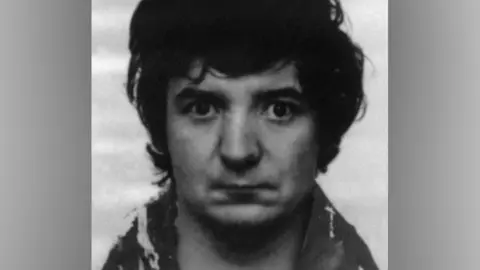BBC News
BBC News, Liverpool
 Merseyside Police
Merseyside PoliceA man who has served 38 years in prison for the murder of a woman has had his conviction quashed by the Court of Appeal after new DNA evidence emerged.
Peter Sullivan was jailed over the 1986 killing of 21-year-old barmaid Diane Sindall, who was subjected to a frenzied sexual attack in Birkenhead, Merseyside, as she walked home from a shift.
The Criminal Cases Review Commission (CCRC) – the statutory body set up to investigate potential miscarriages of justice – had referred Mr Sullivan’s case back to the appeal court last year after fresh testing found a DNA profile pointing to an unknown attacker in semen samples preserved from the crime scene.
Mr Sullivan, appearing on video-link from HMP Wakefield, sobbed and held his hand over his mouth as he was told he would be released.
Now aged 68, he is believed to be the victim of the longest miscarriage of justice involving a living prisoner in British legal history.
In a statement read by his solicitor, Mr Sullivan said he was “not angry, I’m not bitter”.
The statement read: “What happened to me was very wrong but does not detract that what happened was a heinous and most terrible loss of life.
“The truth shall set you free.”
Duncan Atkinson KC, representing the Crown Prosecution Service, had said the service agreed the DNA evidence undermined Mr Sullivan’s conviction and there would be no application to seek a retrial.
Lord Justice Holroyde, sitting with Mr Justice Goss and Mr Justice Bryan at the Royal Courts of Justice in London, quashed the conviction and said they had “no doubt that it is both necessary and expedient in the interests of justice” to admit the new DNA evidence.
He said: “In the light of that evidence, it is impossible to regard the appellant’s conviction as safe.”
Lord Holroyde said injuries to the victim “plainly did point to a sexual aspect of the attack on Miss Sindall” and the “inference was very strong” that the semen had been left by the real killer.

He continued: “There is no evidence to suggest more than one man was involved in the murder, and no evidence to suggest semen may have deposited in the process of consensual sexual activity.”
The court heard technology had only very recently been developed to the point where the semen sample, recovered from Miss Sindall’s abdomen, could be tested for DNA.
The hearing was told the DNA profile was not a match for Miss Sindall’s fiancé at the time, while cross-contamination from the forensic investigator who collected the semen samples had been ruled out.
Merseyside Police has since re-opened its investigation into Miss Sindall’s murder but the force said searches of the national DNA database had not come up with any matches.
Det Ch Supt Karen Jaundrill said more than 260 men have been screened and eliminated from the renewed investigation since 2023.
“We have enlisted specialist skills and expertise from the National Crime Agency, and with their support we are proactively trying to identify the person the DNA profile belongs to, and extensive and painstaking inquiries are underway,” she said.
“We can confirm that the DNA does not belong to any member of Diane’s family, nor Diane’s fiancé at the time, and we believe it could be a vital piece of evidence linking the killer to the scene.”


